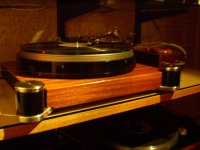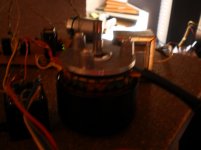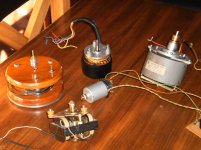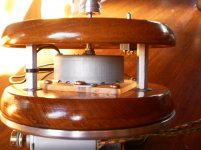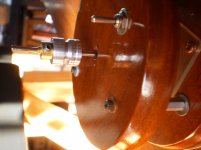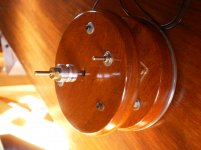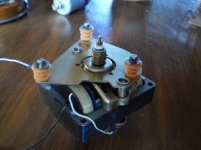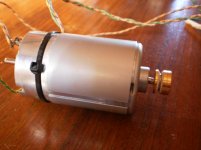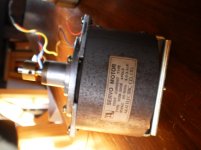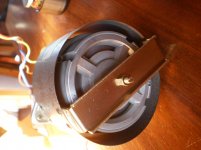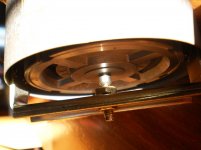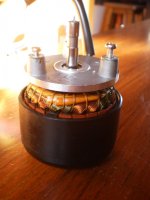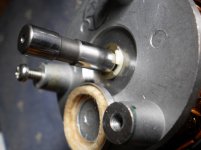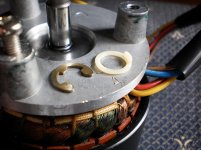hi everybody
Please, I wish to know if the following motor is good for turntable drive duties.
It´s a reel motor, salvaged from an old Akai GX-255 R´to R´.
Outer rotor, Eddy Current type. Four wires -and no servo input at all-, operated with 4uf cap to provide phasing.
930 rpm@50 Hz, 1120 rpm@60 Hz.
Currently, I´m running it from the mains, with a 40 volts AC transformer and 4uF phase capacitor.
It has adequate torque, and is incredibly smooth and silent, but it has noticeable speed drift. I managed to make a pulley for it, but I cant make it run the platter at 33rpm for a long time (in my diy thread driven TT...)
It´s a strange affair: I don´t know if its 2 or 3 phase; and is evident that is not synchronous...
Is feasible to drive it electronically without a lot of expense or complexity?
the motor looks like this:
and that is the tt that i´m using for test duties: a frankenstein using an hybrid platter (strobo dotted from an old DD, plus steel outer ring to add mass and inertia) -more than a turntable, a tweaker´s platform...-
Cheers!!!
Please, I wish to know if the following motor is good for turntable drive duties.
It´s a reel motor, salvaged from an old Akai GX-255 R´to R´.
Outer rotor, Eddy Current type. Four wires -and no servo input at all-, operated with 4uf cap to provide phasing.
930 rpm@50 Hz, 1120 rpm@60 Hz.
Currently, I´m running it from the mains, with a 40 volts AC transformer and 4uF phase capacitor.
It has adequate torque, and is incredibly smooth and silent, but it has noticeable speed drift. I managed to make a pulley for it, but I cant make it run the platter at 33rpm for a long time (in my diy thread driven TT...)
It´s a strange affair: I don´t know if its 2 or 3 phase; and is evident that is not synchronous...
Is feasible to drive it electronically without a lot of expense or complexity?
the motor looks like this:
An externally hosted image should be here but it was not working when we last tested it.
and that is the tt that i´m using for test duties: a frankenstein using an hybrid platter (strobo dotted from an old DD, plus steel outer ring to add mass and inertia) -more than a turntable, a tweaker´s platform...-
Cheers!!!
Attachments
This is an induction motor, but I can't really tell how similar it is to a Papst Aussenlaufer motor, but I suspect it might be worthwhile to come up with some sort of eddy current brake like that used on the Garrard 301 or TD-124, the idea being to load the motor down sufficiently that small variations in loading don't cause a very significant speed change.
My TD-124 runs about a 0.5 - 1% slow depending on ambient temperature when stone cold, but it does come up to speed pretty rapidly, and once fully warmed up does not drift at all. (This takes about 10 minutes in a room at 15 - 20C.) I would try some sort of eddy current brake and somewhat higher voltage and see if the speed stability is not better.
My TD-124 runs about a 0.5 - 1% slow depending on ambient temperature when stone cold, but it does come up to speed pretty rapidly, and once fully warmed up does not drift at all. (This takes about 10 minutes in a room at 15 - 20C.) I would try some sort of eddy current brake and somewhat higher voltage and see if the speed stability is not better.
hi, Kevinkr.
Yes, the motor is some kind of induction motor turned inside out, and now i´m realizing that it shows the behaviour tipical of that kind of motors...
The platter of my TT is partly steel, so a magnetic brake is doable without much trouble: I think that for now I will be using some neodymium magnets from a hard drive, and a threaded mechanism to tune it
I have tested, a lot of motors. One of the best is one very simple synchronous that I made using a microwave oven motor (tray motor): I dissasembled the geared mechanism, putting a spindle in the magnet, a pair of oilite bushings and a metal/wood structure to contain the device. I will post a pic soon.
Another excellent motor is one salvaged from an old changer: is a mixture of induction motor and synchronous motor, nicely machined. The rotor is squirrel cage type, but has attached a permanent magnet... It has excellent torque, and very good speed stability.
But the Akai motor that originated this thread is smoother, devoid of any kind of cogging, and I wish to use it too.
As you have noted, it has some reasemblance with the Papst outer rotor, but with four wires instead of three...
Cheers!
Yes, the motor is some kind of induction motor turned inside out, and now i´m realizing that it shows the behaviour tipical of that kind of motors...
The platter of my TT is partly steel, so a magnetic brake is doable without much trouble: I think that for now I will be using some neodymium magnets from a hard drive, and a threaded mechanism to tune it
I have tested, a lot of motors. One of the best is one very simple synchronous that I made using a microwave oven motor (tray motor): I dissasembled the geared mechanism, putting a spindle in the magnet, a pair of oilite bushings and a metal/wood structure to contain the device. I will post a pic soon.
Another excellent motor is one salvaged from an old changer: is a mixture of induction motor and synchronous motor, nicely machined. The rotor is squirrel cage type, but has attached a permanent magnet... It has excellent torque, and very good speed stability.
But the Akai motor that originated this thread is smoother, devoid of any kind of cogging, and I wish to use it too.
As you have noted, it has some reasemblance with the Papst outer rotor, but with four wires instead of three...
Cheers!
this dc motor was taken from a HP printer. Nothing fancy, but is powerful and surprisingly silent. I´m using it with a very simple L200 variable voltage PSU: not the last word in stability (there is a little drift, +/- 1% in an hour or so), but no severe wow or flutter.
the part is C2162-6006 HP / (Mabuchi Small DC motor)
the part is C2162-6006 HP / (Mabuchi Small DC motor)
Attachments
this beast is from the same reel to reel whose spool motor originated this thread...
it´s a servo AC, for capstan drive.
Eddy Current, outer rotor.
I´m thinking of making a servo for it, looks very promising.
it´s a servo AC, for capstan drive.
Eddy Current, outer rotor.
I´m thinking of making a servo for it, looks very promising.
Attachments
from what I remember reel motors don't have good speed regulation or torque. The reel motors on my old Teac RR would pick up or slow down speed as the reels would fill/empty. A direct drive capstan motor would be a much better choice as they have low rumble and constant speed (low wow and fluter). Is the capstan motor a servo motor or are the extra wires there to provide different speeds ie 3 3/4, 7.5, 15 ips. Most of the speed variations on induction/synchronous motors would come form the slight variations in the power line frequency. This can be almost eliminated with a good oscilator. Capstan motors have good start up torque as they have to ramp up to speed very quickly from stop. Some decks keep the capstan running nearly always and move an idler to push the tape against the already spinning capstan. Since you are building a turntable motor, start up torque is not a real issue but speed stability is. think large flywheel.
hi, multisync.
the capstan motor is a servo ac unit.
The Akai manual states that the function of the servo is solely to provide stable speed, and i don´t know really if speed change is managed via servo or via conmutation of wires... for me at last, the diagram of reel to reel machines is difficult to understand...
I managed to make it work connecting it in the same fashion as the reel motor: 40 volts ac (it admits 80 volts ac maximum) and a cap to provide phasing.
Is very silent, except for a faint whirl from the cooling fan. Torque in spades.
the capstan motor is a servo ac unit.
The Akai manual states that the function of the servo is solely to provide stable speed, and i don´t know really if speed change is managed via servo or via conmutation of wires... for me at last, the diagram of reel to reel machines is difficult to understand...
I managed to make it work connecting it in the same fashion as the reel motor: 40 volts ac (it admits 80 volts ac maximum) and a cap to provide phasing.
Is very silent, except for a faint whirl from the cooling fan. Torque in spades.
My two cents worth
Hello federico moreno,
Knowing a little about tape decks, I would like to tell you that your reel motors are a special kind of induction motor. They are what is referred to as "Torque Motors" The coils and the insulation are designed to allow the motor to be stalled or rotated in the "wrong" direction. Basically, the reel motors are wired to rotate away from each other where they are actually trying to strech the tape. In the case of Scully Decks, they applied 35VAC to each motor which resulted in a tension of 6 ozs. for 1/4" tape. In fast forward they would apply 70VAC to the take-up motor which would force the supply motor to totate backwards to the direction it was wired. Then in rewind the whole scheme would be reversed.
To make a servo motor out of the reel motor, you would have to add a tachometer to one end of the motor shaft which would probably be expensive when you add the electronic control circuit.
Sincerely,
Ralf
Hello federico moreno,
Knowing a little about tape decks, I would like to tell you that your reel motors are a special kind of induction motor. They are what is referred to as "Torque Motors" The coils and the insulation are designed to allow the motor to be stalled or rotated in the "wrong" direction. Basically, the reel motors are wired to rotate away from each other where they are actually trying to strech the tape. In the case of Scully Decks, they applied 35VAC to each motor which resulted in a tension of 6 ozs. for 1/4" tape. In fast forward they would apply 70VAC to the take-up motor which would force the supply motor to totate backwards to the direction it was wired. Then in rewind the whole scheme would be reversed.
To make a servo motor out of the reel motor, you would have to add a tachometer to one end of the motor shaft which would probably be expensive when you add the electronic control circuit.
Sincerely,
Ralf
To make a servo motor out of the reel motor, you would have to add a tachometer to one end of the motor shaft which would probably be expensive when you add the electronic control circuit.
Thanks, Ralf. Evidently, for the next months I´ll have to accept some speed drift or make some sort of eddy brake...
Now I´m testing the Akai capstan motor: is much, much more stable, but it must be handled with utmost care: has lots of torque, plus solid flywheel effect.
At some instance, the thread belt got trapped in the pulley fixture screw, wrapping itself like a fishing reel, and the motor shocked the side of the TT... scary thing!!
By the way, my sincerest congratulations with your linear tonearm: it´s a beauty!! I discovered the thread about it yesterday, and was amazed!!!
I´m trying to make myself some time to read the whole of it...
Hope you can market it succesfully; it´s a gem of industrial design at it´s best
cheers, and thanks!!
...another thing that i have noticed, after much inspection, is that the reel motor appears to be designed for horizontal operation (strange thing, because the deck has four rubber feet in the rear, supposedly for horizontal usage...)
In vertical position, the rotor of the reel motor hangs from the upper bearing, being hold in place by a pressure grommet and some sort of nylon spacer. It has no support whatsoever in the end of the spindle. So the grommet supports all the weight of the rotor, making the friction rather hard. The rotor does not spin freely: it stops in short time...
Instead, in horizontal position shows no sign of friction, and spins with freedom.
more strange so, because the capstan motor yes has vertical support (a nude threaded insert with little hardened steel ball, very similar to a turntable bearing). In vertical position spins with the same ease as in horizontal position, without any problem.
I hope all this rambling will be of any kind of utility for everyone thinking about using reel to reel motors in turntables (as suggested in other threads): not every motor, -no matter how nicely made- is suited to vertical operation. I think that they can be modified (maybe with a spring, a cup and a captive ball), but that implies major surgery...
In vertical position, the rotor of the reel motor hangs from the upper bearing, being hold in place by a pressure grommet and some sort of nylon spacer. It has no support whatsoever in the end of the spindle. So the grommet supports all the weight of the rotor, making the friction rather hard. The rotor does not spin freely: it stops in short time...
Instead, in horizontal position shows no sign of friction, and spins with freedom.
more strange so, because the capstan motor yes has vertical support (a nude threaded insert with little hardened steel ball, very similar to a turntable bearing). In vertical position spins with the same ease as in horizontal position, without any problem.
I hope all this rambling will be of any kind of utility for everyone thinking about using reel to reel motors in turntables (as suggested in other threads): not every motor, -no matter how nicely made- is suited to vertical operation. I think that they can be modified (maybe with a spring, a cup and a captive ball), but that implies major surgery...

Brakes?
...another thing that i have noticed,
In vertical position, the rotor of the reel motor hangs from the upper bearing, being hold in place by a pressure grommet and some sort of nylon spacer. It has no support whatsoever in the end of the spindle. So the grommet supports all the weight of the rotor, making the friction rather hard. The rotor does not spin freely: it stops in short time...QUOTE]
Hello federico moreno,
I doubt that the motor only has a single bearing. I think, there must be another one buried down inside somewhere.
Your tape deck is obviously of the 3-motor type and as such probably qualifies to be called a professional tape deck. Reel motors of these decks usually incorporate some sort of brake which is engaged when the power is off. That means, if the deck's rubber feet indicate that the reel motors would be in the vertical when the deck is in operation the rotors of the reel motors would be resting on the brakes and thus would not turn freely.
May be some of the wires coming out of the motor are for the brake?
Sincerely,
Ralf
Hello, Ralf.
Yes, the motor has two bearings (more exactly, two bronze bushes), upper and lower.
But it lacks any form of support from beneath when in vertical position. So the rotor literally ¨hangs¨ from the metal structure that contains the stator, and the weight is supported only for the pressure grommet that holds the spindle in place.
(I don´t know which is, in english, the name of this type of grommet: is the kind of open flat grommet, ¨omega¨ shaped, that locks in a slot machined ex-profeso in the spindle)
In tandem with that flat grommet is some sort of nylon spacer: it avoids that the grommet and the upper bearing rub against each other.
So: with the motor in vertical the friction is not extreme. It´s barely noticeable. But I think that introduces enough drag to unease the free spin of the motor. That, plus changes in oil viscosity when the motor is warm (after running for 20 minutes), and, moreso, changes in the turntable spindle oil after some usage, maybe led to the speed drift described... Being an induction motor, maybe those factors alone are enough to upset the speed in such a manner.
I think (but I don´t know really) that the braking is done mechanically, via some sort of gross fabric strap wrapped around the base of the hubs (some sort of circular alu platters...)
Wires: all of the wires coming from the motor were connected to a 4 uf capacitor and to ac.
Anyway, I´ll disassemble the motor and post some pics soon: it´s interesting stuff to watch.
Cheers!
Yes, the motor has two bearings (more exactly, two bronze bushes), upper and lower.
But it lacks any form of support from beneath when in vertical position. So the rotor literally ¨hangs¨ from the metal structure that contains the stator, and the weight is supported only for the pressure grommet that holds the spindle in place.
(I don´t know which is, in english, the name of this type of grommet: is the kind of open flat grommet, ¨omega¨ shaped, that locks in a slot machined ex-profeso in the spindle)
In tandem with that flat grommet is some sort of nylon spacer: it avoids that the grommet and the upper bearing rub against each other.
So: with the motor in vertical the friction is not extreme. It´s barely noticeable. But I think that introduces enough drag to unease the free spin of the motor. That, plus changes in oil viscosity when the motor is warm (after running for 20 minutes), and, moreso, changes in the turntable spindle oil after some usage, maybe led to the speed drift described... Being an induction motor, maybe those factors alone are enough to upset the speed in such a manner.
I think (but I don´t know really) that the braking is done mechanically, via some sort of gross fabric strap wrapped around the base of the hubs (some sort of circular alu platters...)
Wires: all of the wires coming from the motor were connected to a 4 uf capacitor and to ac.
Anyway, I´ll disassemble the motor and post some pics soon: it´s interesting stuff to watch.
Cheers!
- Status
- This old topic is closed. If you want to reopen this topic, contact a moderator using the "Report Post" button.
- Home
- Source & Line
- Analogue Source
- using an akai reel motor as turntable drive?
